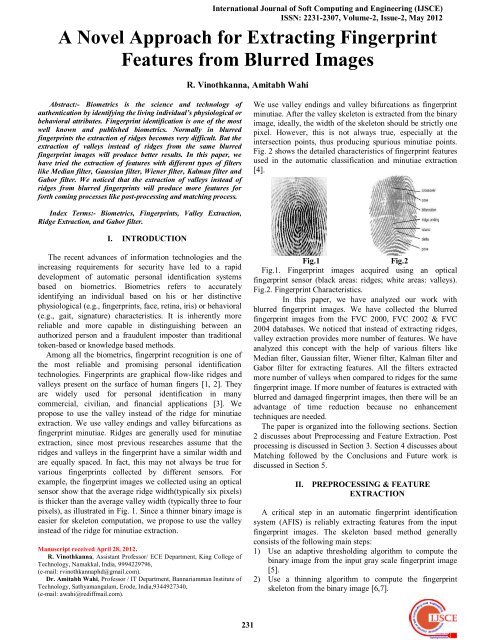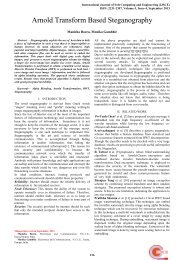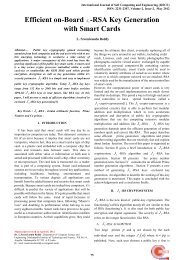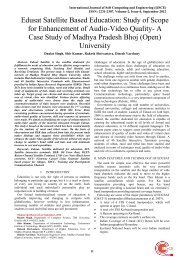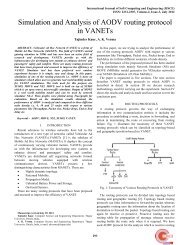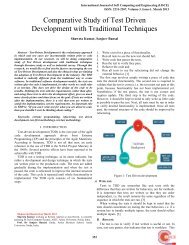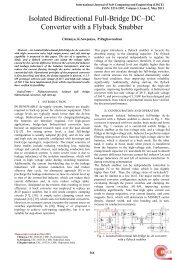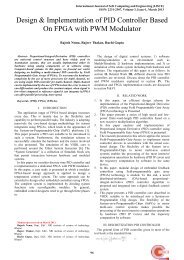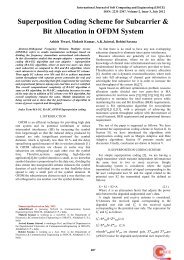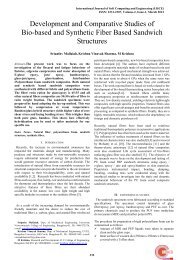A Novel Approach for Extracting Fingerprint Features from Blurred ...
A Novel Approach for Extracting Fingerprint Features from Blurred ...
A Novel Approach for Extracting Fingerprint Features from Blurred ...
You also want an ePaper? Increase the reach of your titles
YUMPU automatically turns print PDFs into web optimized ePapers that Google loves.
International Journal of Soft Computing and Engineering (IJSCE)<br />
ISSN: 2231-2307, Volume-2, Issue-2, May 2012<br />
A <strong>Novel</strong> <strong>Approach</strong> <strong>for</strong> <strong>Extracting</strong> <strong>Fingerprint</strong><br />
<strong>Features</strong> <strong>from</strong> <strong>Blurred</strong> Images<br />
R. Vinothkanna, Amitabh Wahi<br />
Abstract:- Biometrics is the science and technology of<br />
authentication by identifying the living individual’s physiological or<br />
behavioral attributes. <strong>Fingerprint</strong> identification is one of the most<br />
well known and published biometrics. Normally in blurred<br />
fingerprints the extraction of ridges becomes very difficult. But the<br />
extraction of valleys instead of ridges <strong>from</strong> the same blurred<br />
fingerprint images will produce better results. In this paper, we<br />
have tried the extraction of features with different types of filters<br />
like Median filter, Gaussian filter, Wiener filter, Kalman filter and<br />
Gabor filter. We noticed that the extraction of valleys instead of<br />
ridges <strong>from</strong> blurred fingerprints will produce more features <strong>for</strong><br />
<strong>for</strong>th coming processes like post-processing and matching process.<br />
We use valley endings and valley bifurcations as fingerprint<br />
minutiae. After the valley skeleton is extracted <strong>from</strong> the binary<br />
image, ideally, the width of the skeleton should be strictly one<br />
pixel. However, this is not always true, especially at the<br />
intersection points, thus producing spurious minutiae points.<br />
Fig. 2 shows the detailed characteristics of fingerprint features<br />
used in the automatic classification and minutiae extraction<br />
[4].<br />
Index Terms:- Biometrics, <strong>Fingerprint</strong>s, Valley Extraction,<br />
Ridge Extraction, and Gabor filter.<br />
I. INTRODUCTION<br />
The recent advances of in<strong>for</strong>mation technologies and the<br />
increasing requirements <strong>for</strong> security have led to a rapid<br />
development of automatic personal identification systems<br />
based on biometrics. Biometrics refers to accurately<br />
identifying an individual based on his or her distinctive<br />
physiological (e.g., fingerprints, face, retina, iris) or behavioral<br />
(e.g., gait, signature) characteristics. It is inherently more<br />
reliable and more capable in distinguishing between an<br />
authorized person and a fraudulent imposter than traditional<br />
token-based or knowledge based methods.<br />
Among all the biometrics, fingerprint recognition is one of<br />
the most reliable and promising personal identification<br />
technologies. <strong>Fingerprint</strong>s are graphical flow-like ridges and<br />
valleys present on the surface of human fingers [1, 2]. They<br />
are widely used <strong>for</strong> personal identification in many<br />
commercial, civilian, and financial applications [3]. We<br />
propose to use the valley instead of the ridge <strong>for</strong> minutiae<br />
extraction. We use valley endings and valley bifurcations as<br />
fingerprint minutiae. Ridges are generally used <strong>for</strong> minutiae<br />
extraction, since most previous researches assume that the<br />
ridges and valleys in the fingerprint have a similar width and<br />
are equally spaced. In fact, this may not always be true <strong>for</strong><br />
various fingerprints collected by different sensors. For<br />
example, the fingerprint images we collected using an optical<br />
sensor show that the average ridge width(typically six pixels)<br />
is thicker than the average valley width (typically three to four<br />
pixels), as illustrated in Fig. 1. Since a thinner binary image is<br />
easier <strong>for</strong> skeleton computation, we propose to use the valley<br />
instead of the ridge <strong>for</strong> minutiae extraction.<br />
Manuscript received April 28, 2012.<br />
R. Vinothkanna, Assistant Professor/ ECE Department, King College of<br />
Technology, Namakkal, India, 9994229796,<br />
(e-mail: rvinothkannaphd@gmail.com).<br />
Dr. Amitabh Wahi, Professor / IT Department, Bannariamman Institute of<br />
Technology, Sathyamangalam, Erode, India,9344927340,<br />
(e-mail: awahi@rediffmail.com).<br />
Fig.1<br />
Fig.2<br />
Fig.1. <strong>Fingerprint</strong> images acquired using an optical<br />
fingerprint sensor (black areas: ridges; white areas: valleys).<br />
Fig.2. <strong>Fingerprint</strong> Characteristics.<br />
In this paper, we have analyzed our work with<br />
blurred fingerprint images. We have collected the blurred<br />
fingerprint images <strong>from</strong> the FVC 2000, FVC 2002 & FVC<br />
2004 databases. We noticed that instead of extracting ridges,<br />
valley extraction provides more number of features. We have<br />
analyzed this concept with the help of various filters like<br />
Median filter, Gaussian filter, Wiener filter, Kalman filter and<br />
Gabor filter <strong>for</strong> extracting features. All the filters extracted<br />
more number of valleys when compared to ridges <strong>for</strong> the same<br />
fingerprint image. If more number of features is extracted with<br />
blurred and damaged fingerprint images, then there will be an<br />
advantage of time reduction because no enhancement<br />
techniques are needed.<br />
The paper is organized into the following sections. Section<br />
2 discusses about Preprocessing and Feature Extraction. Post<br />
processing is discussed in Section 3. Section 4 discusses about<br />
Matching followed by the Conclusions and Future work is<br />
discussed in Section 5.<br />
II. PREPROCESSING & FEATURE<br />
EXTRACTION<br />
A critical step in an automatic fingerprint identification<br />
system (AFIS) is reliably extracting features <strong>from</strong> the input<br />
fingerprint images. The skeleton based method generally<br />
consists of the following main steps:<br />
1) Use an adaptive thresholding algorithm to compute the<br />
binary image <strong>from</strong> the input gray scale fingerprint image<br />
[5].<br />
2) Use a thinning algorithm to compute the fingerprint<br />
skeleton <strong>from</strong> the binary image [6,7].<br />
231
A <strong>Novel</strong> <strong>Approach</strong> <strong>for</strong> <strong>Extracting</strong> <strong>Fingerprint</strong> <strong>Features</strong> <strong>from</strong> <strong>Blurred</strong> Images<br />
3) Use a suitable filter to extract features <strong>from</strong> the skeleton<br />
of fingerprint image [8,9].<br />
4) Post processing the minutiae set according to some<br />
heuristic rules [10].<br />
The pre-processing of a fingerprint image comprises of<br />
procedures like, first the enhancement of image is done by<br />
histogram equalization. After this the process of binarization is<br />
done on the enhanced fingerprint image by using locally<br />
adaptive method. This binarized fingerprint image is<br />
segmented by using threshold or region of interest techniques<br />
[11]. By observation of the skeleton images and their<br />
corresponding binary images, it can be seen that the<br />
misconnections and the isolated regions (hole, dot, and island)<br />
in the binary images introduce a number of spurious minutiae<br />
in the skeleton images. The Binarization of fingerprint image<br />
is to convert an image up to 256 gray levels to white and black<br />
image. A locally adaptive binarization method is used in<br />
which image binarization is done by choose mean intensity<br />
value or threshold value and classify all pixels with or above<br />
threshold value as white and other pixels as black [12].<br />
Separating the fingerprint area <strong>from</strong> the background is always<br />
useful to avoid extraction of noisy areas of fingerprint [13].<br />
A. 2D Digital Filters<br />
The concept of Minutiae extraction (both ridges and<br />
valleys) of the fingerprint image can be extracted by any filter<br />
and the numbers of features are compared by us. Normally 2D<br />
digital filters are central to many image processing<br />
applications such as image enhancement, image deblurring,<br />
target matching etc. FIR (Finite Impulse Response) digital<br />
filters of the non recursive type can be realized by means of a<br />
simple hardware or software, and so mainly used <strong>for</strong> digital<br />
image processing [14].<br />
In image processing, filters are mainly used to<br />
suppress either the high frequencies in the image that is<br />
smoothing the image, or low frequencies that is enhancing or<br />
detecting edges in the image. An image can be filtered either<br />
in the frequency or in the spatial domain. The first involves<br />
trans<strong>for</strong>ming the image into the frequency domain,<br />
multiplying it with the frequency filter function and<br />
retrans<strong>for</strong>ming the result into the spatial domain. The filter<br />
function is shaped so as to alternate some frequencies and<br />
enhance others. For example, a simple low pass function is l<br />
<strong>for</strong> frequencies smaller than the cut off frequency and 0 <strong>for</strong> all<br />
others [15].<br />
The corresponding process in the spatial domain is to<br />
convolve the input image f(i,j) with the filter function h(i,j).<br />
This can be written as<br />
g(i,j) = h(i,j)°f(i,j) (1)<br />
g(i,j) is the output image after per<strong>for</strong>ming filtering<br />
action with the input image and ° is the symbol used <strong>for</strong><br />
convolution here [16,17].<br />
In this paper, we have used different types of filters<br />
like Median filter, Gaussian filter, Wiener filter, Kalman filter<br />
and Gabor filter <strong>for</strong> extracting both ridges and valleys<br />
separately <strong>from</strong> the same blurred fingerprint images.<br />
B. Median filter<br />
A median filter is a non-linear digital filter which is able to<br />
preserve sharp signal changes and is very effective in<br />
removing impulse noise (or salt and pepper noise) [18]. An<br />
impulse noise has a gray level with higher or lower value that<br />
is different <strong>from</strong> the neighborhood point. Linear filters have<br />
no ability to remove this type of noise without affecting the<br />
distinguishing characteristics of the signal. Median filters have<br />
remarkable advantages over linear filters <strong>for</strong> this particular<br />
type of noise. There<strong>for</strong>e median filter is very widely used in<br />
digital signal and image/video processing applications. When<br />
median filters are applied to an image, the pixel values which<br />
are very different <strong>from</strong> their neighboring pixels will be<br />
eliminated. By eliminating the effect of such odd pixels, the<br />
values are assigned to the pixels that are representative of the<br />
values of the typical neighboring pixel in the original image<br />
[18, 19].<br />
For any probability distribution on the real line with<br />
cumulative distribution function F, regardless of whether it<br />
is any kind of continuous probability distribution, in particular<br />
an absolutely continuous distribution (and there<strong>for</strong>e has a<br />
probability density function), or a discrete probability<br />
distribution, a median m satisfies the inequalities<br />
P(X≤m)≥1/2 and P(X≥m)≥1/2 (2)<br />
in which a Lebesgue – Stieltjes integral is used. For an<br />
absolutely continuous probability distribution with probability<br />
density function ƒ, we have<br />
P(X≤m) = P(X≥m) =∫f(x)dx (-∞,m) = ½ (3)<br />
C. Gaussian Filter<br />
Gaussian filters are a class of linear smoothing filters with<br />
the weights chosen according to the shape of a Gaussian<br />
function. The Gaussian kernel is widely used <strong>for</strong> smoothing<br />
purpose. The equation of Gaussian filter in one dimension is<br />
given by<br />
G(x)=(1/√(2πσ 2 ))e^(-x 2 /2σ 2 ) (4)<br />
In two dimensions, it is the product of two such Gaussians,<br />
one in each dimension<br />
G(x,y)=(1/(2πσ 2 ))e^(-(x 2 +y 2 )/2σ 2 ) (5)<br />
Where x is the distance <strong>from</strong> the origin in the horizontal<br />
axis, y is the distance <strong>from</strong> the origin in the vertical axis, and σ<br />
is the standard deviation of the Gaussian distribution.<br />
When applied in two dimensions, this <strong>for</strong>mula produces a<br />
surface whose contours are concentric circles with a<br />
Gaussian distribution <strong>from</strong> the center point. Values <strong>from</strong> this<br />
distribution are used to build a convolution matrix which is<br />
applied to the original image. Each pixel's new value is set to a<br />
weighted average of that pixel's neighborhood. The original<br />
pixel's value receives the heaviest weight (having the highest<br />
Gaussian value) and neighboring pixels receive smaller<br />
weights as their distance to the original pixel increases. This<br />
results in a blur that preserves boundaries and edges better<br />
than other, more uni<strong>for</strong>m blurring filters.<br />
The Gaussian smoothing filter is a very good filter <strong>for</strong><br />
removing noise drawn <strong>from</strong> a normal distribution. Gaussian<br />
smoothing is a particular class of averaging, in which the<br />
kernel is a 2D Gaussian. Gaussian functions have the<br />
232
following properties that make them useful in image<br />
processing, they are (i) Gaussian functions are rotationally<br />
symmetric in two dimensions so it will not bias subsequent<br />
edge detection in any particular direction. (ii) The Fourier<br />
trans<strong>for</strong>m of a Gaussian function is itself a Gaussian function.<br />
(iii) The degree of smoothening is governed by variance σ. A<br />
larger variance σ implies a wider Gaussian filter and greater<br />
smoothening. (iv) Two-dimensional Gaussian functions are<br />
separable. This property implies that large Gaussian filters can<br />
be implemented very efficiently [19].<br />
D. Wiener Filter<br />
Wiener filter is used to reduce the amount of noise present<br />
in a signal by comparison with an estimation of the desired<br />
noiseless signal. The Wiener-Kolmogorov was the first<br />
statistically designed filter to be proposed and subsequently<br />
gave rise to many others including the famous Kalman filter.<br />
A Wiener filter is not an adaptive filter because the theory<br />
behind this filter assumes that the inputs are stationary.<br />
Suppose a vector S is corrupted by Gaussian white noise with<br />
variance σ2 and mean 0, X = S + σZ. Wiener filtering is the<br />
following linear procedure,<br />
X^ = Σm(βm2/ βm2+σ2)[X,gm]gm (6)<br />
Here βm and gm are Eigen values and eigenvectors of the<br />
covariance matrix (Karhuen-Loeve trans<strong>for</strong>m) of S. If S is<br />
Gaussian then X^ is the best mean square estimate of S. In<br />
order to apply Wiener filter one needs to estimate the<br />
covariance matrix (Karhuen-Loeve trans<strong>for</strong>m) of the signal<br />
[20].<br />
E. Kalman Filter<br />
The main purpose of Kalman filter is to use measurements<br />
observed over time, containing noise (random variations) and<br />
other inaccuracies, and produce values that tend to be closer to<br />
the true values of the measurements and their associated<br />
calculated values. The Kalman filter has many applications in<br />
technology, and is an essential part of space and military<br />
technology development.<br />
In order to use the Kalman filter to estimate the internal<br />
state of a process given only a sequence of noisy observations,<br />
one must model the process in accordance with the framework<br />
of the Kalman filter. This means specifying the following<br />
matrices: Fk, the state-transition model; Hk, the observation<br />
model; Qk, the covariance of the process noise; Rk, the<br />
covariance of the observation noise; and sometimes Bk, the<br />
control-input model, <strong>for</strong> each time-step, k, as described below.<br />
The Kalman filter model assumes the true state at time k is<br />
evolved <strong>from</strong> the state at (k − 1) according to<br />
X k = F k X k-1 +B k u k +w k (7)<br />
International Journal of Soft Computing and Engineering (IJSCE)<br />
ISSN: 2231-2307, Volume-2, Issue-2, May 2012<br />
At time k an observation (or measurement) z k of the true state<br />
x k is made according to<br />
Z k = H k x k +v k (9)<br />
where H k is the observation model which maps the true state<br />
space into the observed space and v k is the observation noise<br />
which is assumed to be zero mean Gaussian white noise with<br />
covariance R k .<br />
V k N(0,R k ) (10)<br />
The initial state, and the noise vectors at each step {x0, w1,<br />
..., wk, v1 ... vk} are all assumed to be mutually independent.<br />
Many real dynamical systems do not exactly fit this model.<br />
In fact, unmodelled dynamics can seriously degrade the filter<br />
per<strong>for</strong>mance, even when it was supposed to work with<br />
unknown stochastic signals as inputs. The reason <strong>for</strong> this is<br />
that the effect of unmodelled dynamics depends on the input,<br />
and, there<strong>for</strong>e, can bring the estimation algorithm to instability<br />
(it diverges). On the other hand, independent white noise<br />
signals will not make the algorithm diverge. The problem of<br />
separating between measurement noise and unmodelled<br />
dynamics is a difficult one and is treated in control theory<br />
under the framework of robust control [21].<br />
F. Gabor filter<br />
In image processing, a Gabor filter, is a linear filter used<br />
<strong>for</strong> edge detection. Frequency and orientation representations<br />
of Gabor filters are similar to those of the human visual<br />
system, and they have been found to be particularly<br />
appropriate <strong>for</strong> texture representation and discrimination. In<br />
the spatial domain, a 2D Gabor filter is a Gaussian kernel<br />
function modulated by a sinusoidal plane wave. The Gabor<br />
filters are self-similar: all filters can be generated <strong>from</strong> one<br />
mother wavelet by dilation and rotation. Thus, image<br />
analysis by the Gabor functions is similar to perception in the<br />
human visual system.<br />
Its impulse response is defined by a harmonic function<br />
multiplied by a Gaussian function. Because of the<br />
multiplication-convolution property (Convolution theorem),<br />
the Fourier trans<strong>for</strong>m of a Gabor filter's impulse response is<br />
the convolution of the Fourier trans<strong>for</strong>m of the harmonic<br />
function and the Fourier trans<strong>for</strong>m of the Gaussian function.<br />
The filter has a real and an imaginary component representing<br />
orthogonal directions. The two components may be <strong>for</strong>med<br />
into a complex number or used individually.<br />
Complex<br />
G(x,y;λ,θ,Ψ,σ,γ) = exp (-(x’ 2 +γ 2 y’ 2 )/2σ 2 ) exp(i(2π(x’/λ)+Ψ))<br />
(11)<br />
Where<br />
F k is the state transition model which is applied to the<br />
previous state x k−1 ;<br />
B k is the control-input model which is applied to the<br />
control vector u k ;<br />
w k is the process noise which is assumed to be drawn<br />
<strong>from</strong> a zero mean multivariate normal distribution<br />
with covariance Q k .<br />
W k N(0,Q k ) (8)<br />
Real<br />
G(x,y;λ,θ,Ψ,σ,γ) = exp (-(x’ 2 +γ 2 y’ 2 )/2σ 2 ) cos(2π(x’/λ)+Ψ)<br />
(12)<br />
Imaginary<br />
G(x,y;λ,θ,Ψ,σ,γ) = exp (-(x’ 2 +γ 2 y’ 2 )/2σ 2 ) sin(2π(x’/λ)+Ψ)<br />
(13)<br />
Where x’ = x cos +y sin (14)<br />
And y’ = - x sin+y cos (15)<br />
233
A <strong>Novel</strong> <strong>Approach</strong> <strong>for</strong> <strong>Extracting</strong> <strong>Fingerprint</strong> <strong>Features</strong> <strong>from</strong> <strong>Blurred</strong> Images<br />
In this equation, λ represents the wavelength of the<br />
sinusoidal factor, θ represents the orientation of the normal to<br />
the parallel stripes of a Gabor function, ψ is the phase offset,<br />
σ is the sigma of the Gaussian envelope and γ is the spatial<br />
aspect ratio, and specifies the ellipticity of the support of the<br />
Gabor function [8].<br />
In our future work, we are going to modify all the above<br />
mentioned filters to check the above results.<br />
Also, we are trying to reduce the time elapsed <strong>for</strong> valley<br />
extraction, because in Automatic <strong>Fingerprint</strong><br />
Identification System (AFIS) time reduction is a very<br />
important factor.<br />
III. POST PROCESSING<br />
After preprocessing on the binary and skeleton images, we<br />
extract all the minutiae <strong>from</strong> the fingerprint skeleton using any<br />
one of the above mentioned filters. However, due to various<br />
noises in the fingerprint image, the extraction algorithm<br />
produces a large number of spurious minutiae such as break,<br />
spur, bridge, merge, triangle, ladder, lake, island, and wrinkle.<br />
There<strong>for</strong>e, reliably differentiating spurious minutiae <strong>from</strong><br />
genuine minutiae in the Post processing stage is crucial <strong>for</strong><br />
accurate fingerprint recognition. The more spurious minutiae<br />
are eliminated, the better the matching per<strong>for</strong>mance will be. In<br />
addition, matching time will be significantly reduced because<br />
of the reduced minutiae number. This is very important since<br />
the execution time is a critical parameter in an AFIS.<br />
After the false minutiae are removed, the original extracted<br />
features <strong>from</strong> the image is alone stored in the database. While<br />
storing the features, the respective identity of the person ((i.e.)<br />
name, number etc) is allotted <strong>for</strong> each image <strong>for</strong> further<br />
identification [22].<br />
IV. MATCHING<br />
<strong>Fingerprint</strong> matching is based on finding the Euclidean<br />
distance between the corresponding feature vectors. This<br />
minimum score corresponds to the best alignment of the two<br />
fingerprints being matched. If the Euclidean distance between<br />
two feature vectors is less than a threshold, then the decision<br />
that “the two images come <strong>from</strong> the same finger” is made,<br />
otherwise a decision that “the two images come <strong>from</strong> different<br />
fingers” is made.<br />
Since the template generation <strong>for</strong> storage in the database is<br />
an offline process the verification time still depends on the<br />
time taken to generate a single template [23].<br />
V. CONCLUSION AND FUTURE WORK<br />
A. Conclusion<br />
From this work, we have analyzed the following points,<br />
When compared to ridges in blurred fingerprint image, more<br />
number of valleys can be extracted. So if blurred fingerprint<br />
images are obtained we can go extracting valleys instead of<br />
ridges, because in some blurred fingerprints not even a single<br />
ridge can be extracted. But we observed in this work that 3 to<br />
4 valleys are obtained in the same fingerprint image. All filters<br />
have extracted more number of valleys than ridges in this<br />
work. But time elapsed <strong>for</strong> ridge extraction is less when<br />
compared to valley extraction. But this disadvantage can be<br />
neglected in the case of blurred fingerprint images and also<br />
enhancement of images is not required in this work.<br />
Future Work<br />
ACKNOWLEDGMENT<br />
We here by thank Dr. C.Palanisamy and Dr. Harikumar,<br />
Professors of Bannariamman Institute of Technology <strong>for</strong> their<br />
valuable guidance in this work and also Research Grants<br />
Council of the journals of pattern recognition society to<br />
provide online fingerprint database.<br />
REFERENCES<br />
[1] A.K. Jain, R. Bolle, S. Pankanti (Eds.), “Biometrics: Personal<br />
Identification in Networked Society”, Kluwer Academic Publishers,<br />
Boston, 1999.<br />
[2] L.C. Jain, U. Halici, I. Hayashi, S.B. Lee, S. Tsutsui (Eds.), “Intelligent<br />
Biometric Techniques in <strong>Fingerprint</strong> and Face Recognition”, CRC Press,<br />
Boca Raton, 1999.<br />
[3] Nishiuchi. N, Soya. H, “Cancelable Biometric Identification by<br />
Combining Biological Data with Artifacts”, Biometrics and Kansei<br />
Engineering (ICBAKE), 2011 International Conference on 19-22 Sept.<br />
2011, 61-64.<br />
[4] Nalini Ratha, Rudd Bolle, “Automatic Finger print Recognition system”,<br />
Springer New York 2004.<br />
[5] J.R. Parker,” Gray level thresholding in badly illuminated images”,<br />
IEEE Trans. Pattern Anal. Mach. Intell. 13 (8) (1991) 813–819.<br />
[6] Chowdhury. A, “An Effectual Thinning Algorithm”, Electronics<br />
Computer Technology (ICECT), 2011 3rd International Conference on<br />
8-10 April 2011,1, 183 – 187.<br />
[7] Luping Ji, Zhang Yi, Lifeng Shang, Xiaorong Pu, “Binary <strong>Fingerprint</strong><br />
Image Thinning Using Template Based PCNNs”, Systems, Man, and<br />
Cybernetics, Part B: Cybernetics, IEEE Transactions on Oct. 2007,<br />
Volume : 37 , Issue:5 , 1407 – 1413.<br />
[8] Zhang Jinhai, “<strong>Fingerprint</strong> Image Enhancement based on Gabor<br />
Function” Cross Strait Quad-Regional Radio Science and Wireless<br />
Technology Conference (CSQRWC), 2011 , 2, 1414 – 1417.<br />
[9] Heeyeol Yu, Mahapatra R, Bhuyan L, “A Hash-Based Scalable IP<br />
lookup using Bloom and <strong>Fingerprint</strong> filters”, Network Protocols, 2009.<br />
ICNP 2009. 17th IEEE International Conference on 13-16 Oct. 2009,<br />
264 – 273.<br />
[10] Takenga, C. Tao Peng, Kyamakya K, “Post-Processing of <strong>Fingerprint</strong><br />
Localization using Kalman filter and Map-Matching Techniques” ,<br />
Advanced Communication Technology, The 9th International<br />
Conference on 12-14 Feb. 2007,3, 2029 – 2034.<br />
[11] Chitresh Saraswat and Amit Kumar, “An Efficient Automatic<br />
Attendance System using <strong>Fingerprint</strong> Verification Technique”,<br />
International Journal on Computer Science and Engineering Vol. 02, No.<br />
02, 2010, 264-269.<br />
[12] Medeiros. L.X, Flores. E.L, Arantes Carrijo. G, Paschoarelli Veiga. A.C,<br />
“Optimization of Calculation of Field Orientation Time and Binarization<br />
of <strong>Fingerprint</strong> Images”, Latin America Transactions, IEEE (Revista<br />
IEEE America Latina) Sept. 2011, Volume : 9 , Issue:5 , 868 – 874.<br />
[13] Chaur-Chin Chen and Yaw-Yi Wang, “An AFIS Using <strong>Fingerprint</strong><br />
Classification,” Image and Vision Computing, 2003.<br />
[14] Jie-Cherng Liu, Yang-Lung Tai, “ Design of 2-D Wideband Circularly<br />
Symmetric FIR Filters by Multiplierless High-OrderTrans<strong>for</strong>mation”,<br />
Circuits and Systems, IEEE Transactions on April 2011,vol.58,issue 4,<br />
746 – 754.<br />
[15] Rajapaksha, Nilanka T, Madanayake, Arjuna, “Asynchronous – QDI 2D<br />
IIR Digital Filter Circuits”, Circuits and Systems (ISCAS), 2011 IEEE<br />
International Symposium on 15-18 May 2011, 665 – 668.<br />
[16] John C. Ross, “Image Processing Hand Book”, CRC Press. 1994.<br />
[17] S.Jayaraman, S.Esakkirajan, T.Veerakumar, “Digital Image Processing”,<br />
Tata McGraw Hill Education privateLtd,NewDelhi,2009.<br />
[18] Gang Cao; Yao Zhao; Rongrong Ni; Lifang Yu; Huawei Tian, “<br />
Forensic Detection of Median Filtering in Digital Images”, Multimedia<br />
and Expo (ICME), 2010 IEEE International Conference on 19-23 July<br />
2010, 89 – 94.<br />
234
[19] Kanagalakshmi K, Chandra E, “Per<strong>for</strong>mance Evaluation of Filters in<br />
Noise Removal of <strong>Fingerprint</strong> Image”, Electronics Computer<br />
Technology (ICECT), 2011 3rd International Conference on 8-10 April<br />
2011,1, 117 – 121.<br />
[20] Wan.S, Raju. B.I, Srinivasan. M.A, “Robust deconvolution of highfrequency<br />
ultrasound Ultrasonics, Ferroelectrics and Frequency Control,<br />
IEEE Transactions on Oct.wavelets” images using higher-order spectral<br />
analysis and, 2003, Volume : 50 , Issue:10 , 1286 – 1295.<br />
[21] Sun Chun-Jung, Kuo Hong-Yi, Lin Chin E, “A Sensor Based Indoor<br />
Mobile Localization and Navigation Using Unscented Kalman Filter”,<br />
Position Location and Navigation Symposium (PLANS), 2010<br />
IEEE/ION 4-6 May 2010, 327 – 331.<br />
[22] Feng Zhao, Xiaoou Tang, “Preprocessing and Postprocessing <strong>for</strong><br />
skeleton-based fingerprint minutiae extraction,” Pattern Recognition<br />
40(4): 1270-1281 (2007).<br />
[23] Pham. T.Q, Perry. S.W, Fletcher. P.A, Ashman. R.A, “Paper<br />
<strong>Fingerprint</strong>ing using alpha-masked image matching”, Computer Vision,<br />
IET, July 2011, Volume: 5 , Issue:4 , 232 – 243.<br />
International Journal of Soft Computing and Engineering (IJSCE)<br />
ISSN: 2231-2307, Volume-2, Issue-2, May 2012<br />
Mr.R.Vinothkanna, working as Assistant Professor, Department of<br />
Electronics and Communication Engineering, King College of Technology,<br />
Namakkal. His research interest includes Embedded Systems, Biometrics and<br />
Digital Image Processing. He Published 3 research papers in International<br />
Journals, 1 research paper in International Conference and 6 research papers<br />
in National Conferences and Guided 4 Post Graduate Students and many<br />
under graduate Students <strong>for</strong> their project work. He is a Life member of ISTE,<br />
New Delhi and Member of IEEE. He has around 8 years of teaching<br />
experience. He is Pursuing Ph.D., in the Department of Electronics and<br />
Communication Engineering, Anna University of Technology, Coimbatore.<br />
Dr. Amitabh Wahi completed Ph. D. in 1999 in the Department of<br />
Electronics Engineering, Banaras Hindu University, Varanasi. He is working<br />
as Professor, Dept. of In<strong>for</strong>mation Technology, BannariAmman Institute of<br />
Technology, Sathyamangalam. His research interest includes Artificial Neural<br />
Networks (ANNs), Fuzzy Logic, Genetic Algorithms, Image & Video<br />
Processing, Object Recognition and Network Security. He has published 16<br />
research papers in International & National Journals and 30 papers in<br />
International / National Conferences/ Workshops/Seminars etc. Guided one<br />
Ph. D. and two M. Phils. Apart <strong>from</strong> this, ten research scholars are pursuing<br />
Ph.D. under his supervision. Life member of ISTE, New Delhi and CSI,<br />
Mumbai. He has 11 years of teaching and 15 years research experience.<br />
235


